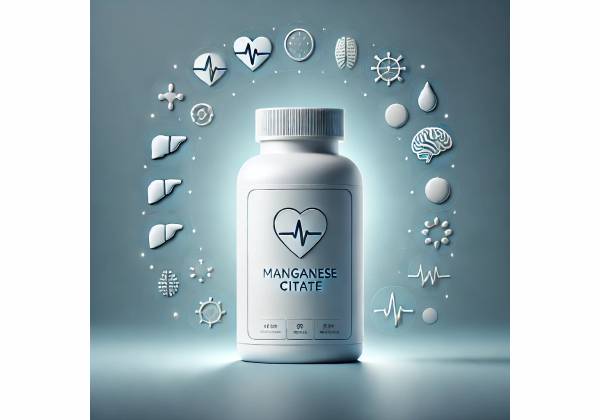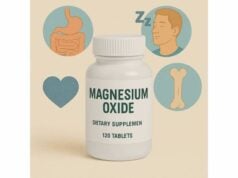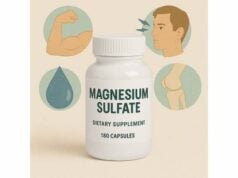
Manganese citrate is a supplemental form of manganese—the essential trace mineral your body uses to build and protect tissues, run enzymes, and manage energy and antioxidant defenses. While most people meet needs through food, manganese citrate appears in multivitamins and stand-alone mineral products because it’s easy to formulate, gentle on the stomach for many users, and provides a predictable amount of elemental manganese per dose. The body absorbs only a small fraction of manganese and regulates it tightly, which is why deficiency is rare yet excess intake can still cause problems, especially with impaired liver or bile function. This guide translates the science into clear steps: when manganese citrate may help, how to dose it safely, who should avoid it, and what to watch for with side effects and drug interactions. You’ll also see how regional safety limits differ, why many benefits rely on enzyme support rather than megadoses, and practical ways to prioritize diet first while using supplements thoughtfully.
Quick Overview
- Supports enzymes for antioxidant defense, connective tissue, and metabolism; typical dietary intakes already meet needs for most adults.
- Side effects are uncommon at modest doses but chronic excess can harm the nervous system; liver or biliary disease raises risk.
- Common supplemental range: 1–5 mg elemental manganese daily; stay below regional safe limits from all sources.
- Avoid use or seek medical guidance if you have chronic liver disease, cholestasis, iron deficiency, or Parkinsonism.
Table of Contents
- What is manganese citrate and how does it work?
- Benefits: what manganese may help (and what it probably does not)
- Who should consider it—and who probably should not
- How much to take and when to take it
- Side effects, safety issues, and red flags
- Interactions, stacking, and practical use tips
What is manganese citrate and how does it work?
Manganese citrate is a salt formed from manganese and citric acid. On a supplement label, the amount listed refers to elemental manganese (the active mineral) rather than the full weight of the compound. Manufacturers choose citrate because it dissolves well in water, tablets, and capsules and is generally well tolerated. In multivitamins, it often appears alongside manganese sulfate, gluconate, or glycinate; all deliver the same mineral ion once absorbed.
Biologically, manganese is a cofactor for several enzymes central to daily function. A prominent example is manganese superoxide dismutase (MnSOD), the antioxidant enzyme that neutralizes superoxide radicals inside mitochondria. Manganese also supports enzymes that process amino acids and carbohydrates and enzymes that help build cartilage and bone matrix. While these roles sound sweeping, they do not imply that more manganese is automatically better. The body contains only about 10–20 mg total, with a quarter to two-fifths in bone. Intestinal absorption is low—commonly estimated around 1–5% of intake—and rises or falls depending on your status. When manganese intake is low, absorption efficiency increases; when intake is high, absorption falls and the liver excretes more in bile. This homeostasis keeps tissue levels fairly steady in healthy people.
Form matters less for manganese than for some minerals. You may see marketing claims that certain chelates (e.g., glycinate) are “more bioavailable.” For manganese specifically, robust human data comparing forms are sparse. Regulatory summaries emphasize that no clear, consistent hierarchy of supplemental forms has been established. In practice, what matters most is the elemental dose, your overall diet, and individual factors that change absorption—such as iron status. Iron and manganese share some intestinal transport pathways; low iron stores can drive up manganese absorption, which has safety implications discussed later.
Because routine blood testing for manganese is not very helpful (levels vary widely and do not track intake reliably), decisions about manganese citrate are best grounded in your diet, medical context, and clear goals (for example, pairing alongside calcium, vitamin D, and others in a bone-support plan when dietary manganese is low). For many adults, food already supplies adequate manganese from whole grains, nuts, legumes, leafy vegetables, coffee or tea, and some shellfish. If you do supplement, think “top-up,” not “mega-dose,” and see sections below for conservative ranges.
Benefits: what manganese may help (and what it probably does not)
Because manganese participates in antioxidant defense and connective-tissue formation, it has been studied for bone health, metabolic health, and neuromuscular function. The quality of human evidence varies by area:
Bone integrity and connective tissue. Manganese helps activate enzymes that cross-link proteoglycans and form healthy cartilage and bone matrix. Animal models consistently show skeletal abnormalities when manganese is deficient and improved indices when manganese is repleted. In humans, the picture is nuanced: observational studies have linked blood manganese levels and bone density, but controlled trials isolating manganese alone are limited. In reality, bone outcomes depend on multiple nutrients (calcium, vitamin D, vitamin K, magnesium, boron, protein) and loading exercise. If your diet is low in nuts, whole grains, and legumes—key manganese sources—small supplemental doses may support this enzyme network as part of a broader bone plan.
Antioxidant and mitochondrial support. Inside mitochondria, MnSOD is indispensable. This has led to interest in manganese’s role in oxidative stress conditions. Still, the body prioritizes manganese for MnSOD even at regular dietary intakes. There is no strong evidence that higher-than-adequate manganese intake further boosts antioxidant defense in healthy adults. Put differently: ensuring sufficiency matters; overshooting does not create extra MnSOD.
Glucose and lipid metabolism. Manganese-dependent enzymes participate in carbohydrate and lipid pathways. Observational research has associated both low and high blood manganese levels with differences in glucose control, suggesting a U-shaped relationship. Animal studies show improvements with manganese repletion; human trials remain limited and heterogeneous. If you’re exploring manganese citrate specifically to improve blood sugar, expectations should be cautious. Focus on diet, activity, weight management, sleep, and medications as the primary levers.
Neuromuscular function. Severe deficiency can cause impaired growth or neuromuscular issues in experimental settings, but deficiency is rare in free-living adults. Conversely, too much manganese is neurotoxic, which is why the “sweet spot” is narrow: assure adequate intake while avoiding excess. Supplementing modestly to cover a demonstrable gap may be reasonable; supplementing aggressively “for energy or brain support” is not.
Who may feel a benefit? People on very restricted diets (e.g., meal-replacement heavy, highly refined, low in whole grains and nuts), those with malabsorption, or long-term parenteral nutrition may see the most practical gains from bringing manganese intake into the typical adequate range. For others who already eat mixed diets, benefits from standalone manganese citrate are likely modest and indirect—supporting enzymes rather than producing an obvious “felt effect.”
What it probably does not do. There’s no convincing human evidence that manganese citrate improves athletic performance, sleep, mood, hair/skin quality, or weight loss on its own. Claims in these areas usually outpace data. If you notice changes after starting a multi-ingredient product, other components (e.g., magnesium, zinc, B-vitamins) could be responsible.
Bottom line: manganese is essential, but more is not better. Use manganese citrate to maintain sufficiency, especially when diet is lacking or your clinician recommends it for a defined reason, not as a general-purpose “booster.”
Who should consider it—and who probably should not
Potential candidates
- Diets low in whole plant foods. If your intake of whole grains, legumes, nuts, and leafy vegetables is minimal, your manganese intake could hover near the lower end of typical intakes. A low-dose supplement can help bridge the gap while you improve dietary patterns.
- Individuals on long-term elimination regimens. Very low-residue or elemental diets, and some medically necessary elimination diets, can reduce trace mineral variety. Targeted supplementation—including manganese—may be part of a clinician-guided plan.
- Patients with increased needs in specific contexts. Adolescents undergoing rapid growth and older adults with low appetite sometimes underconsume trace minerals. The priority is food, but a modest supplement can be reasonable if intake analysis shows persistent shortfalls.
- People using high-dose calcium, iron, or polyphenol supplements that can crowd out trace minerals at meals. Timing manganese away from large competing doses can maintain balance (details in the interactions section).
Who should pause or avoid without medical supervision
- Chronic liver or biliary disease (including cholestasis). Manganese is primarily excreted in bile. Impaired bile flow reduces excretion and can raise brain manganese over time. In these situations, even standard doses can accumulate. Avoid self-supplementation and follow specialist advice.
- Iron deficiency. Low iron status increases intestinal manganese absorption. Treating iron deficiency first is the priority; non-essential manganese supplementation can wait until iron repletion is stable and a clinician confirms it’s appropriate.
- Parkinsonism or manganese exposure history (welding, mining, contaminated water). Additional manganese from supplements is generally not advisable without specialist oversight.
- Infants and young children. Outside of formulas and foods, discretionary manganese supplements are inappropriate. Infants absorb manganese more readily than adults; only use products designed for their age group under pediatric guidance.
- Pregnancy and lactation. Total manganese needs are modestly higher, but safe upper bounds exist. Use prenatal formulas as directed and avoid stacking extra manganese unless recommended by your provider.
Edge cases
- High tea or coffee intake. Tea contributes meaningful manganese; if you drink several cups daily and also use a multivitamin plus a manganese-containing complex, your total may be higher than you realize.
- Heavy multivitamin users. Some products provide 4–5 mg manganese per serving. Combining a multi, a bone formula, and a “trace mineral” complex can add up quickly. Audit your labels.
A thoughtful approach is to inventory your diet and supplements, then add manganese citrate only if there’s a consistent gap or a clinician-defined rationale. When in doubt, aim for adequacy via food first; use supplements to fill—not exceed—needs.
How much to take and when to take it
Understand the baselines. Health authorities publish intake values to guide safe, adequate consumption. For adults, typical daily adequacy targets are around 2.3 mg for men and 1.8 mg for women from all sources (diet plus supplements). Most mixed diets reach those amounts without supplements. Upper limits differ by region and methodology. In the United States, a traditional tolerable upper intake level (UL) of 11 mg/day for adults reflects a threshold unlikely to cause harm in healthy individuals. Recent European risk assessments emphasize a conservative “safe level of intake” of 8 mg/day for adults based on observed diet patterns, underscoring caution around neurotoxicity and uncertainty in dose-response data. Regardless of jurisdiction, these values refer to total manganese from food, water, and supplements.
Supplement ranges that fit real life. If you and your clinician decide on manganese citrate, pragmatic supplemental amounts typically fall between 1 and 5 mg elemental manganese daily, used to top up a diet that might provide 1–3 mg. Many multivitamins provide 1.0–4.5 mg, while single-ingredient products often supply 5–15 mg. Unless you have a documented deficiency or a specific medical indication, staying at the lower end (1–3 mg/day) is sensible. Remember that “elemental” refers to manganese itself; the citrate portion does not count toward dose.
Timing and absorption. Because manganese absorption is low and variable and competes with iron, take manganese citrate at a different time than substantial iron or calcium supplements if possible. A simple pattern is to take iron with breakfast or lunch and manganese (if indicated) with the opposite meal or in the evening. If you drink tea or coffee with meals, recognize that they can contribute manganese (tea) and affect mineral absorption; spacing your supplement from large polyphenol intakes may help maintain predictable uptake.
Cyclic or continuous? For most users, continuous low-dose use is fine when there’s a persistent dietary gap and no liver/bile issues. If you’re taking manganese to cover a temporary shortfall (for example, during a travel period with limited food choices), a time-limited course of 4–8 weeks can be reasonable before reassessing your diet.
Special case: bone support stacks. In bone-health formulas, manganese often accompanies vitamin D3, vitamin K2, calcium, magnesium, silicon, and boron. These combinations make sense mechanistically but can push total manganese higher than needed if you also use a multivitamin. Add the elemental manganese amounts across products; if the sum exceeds 5 mg/day, ask whether you can rely on food plus a single, well-designed formula rather than stacking.
Practical examples
- Diet low in whole grains/nuts; no multivitamin. Consider 1–2 mg/day manganese from a food-first multivitamin or a small standalone tablet while improving diet.
- Using a multivitamin with 2 mg manganese; diet includes 1–2 mg. Additional manganese is usually unnecessary.
- Bone formula includes 4 mg; you also take a multivitamin with 2 mg and drink several cups of tea. You may already be at or above the conservative adult “safe level” depending on diet; streamline products or lower doses.
When to stop or re-evaluate. If you develop new neurological symptoms (tremor, rigidity, balance changes), persistent insomnia or mood shifts, or if you’re diagnosed with liver or biliary disease, discontinue non-essential manganese and seek medical evaluation. Likewise, if iron deficiency is identified, pause manganese supplementation while iron is corrected.
Side effects, safety issues, and red flags
Common tolerance. At low, food-like intakes, most people tolerate manganese well. Occasional users report mild gastrointestinal discomfort when taking mineral tablets on an empty stomach; taking with food typically solves this.
Neurotoxicity with overexposure. The central safety concern is manganese accumulation in the brain with chronic excess exposure, which can produce a syndrome resembling Parkinson’s disease (manganism). This risk is best documented in occupational inhalation (e.g., welding, mining) and contaminated water exposures but is relevant to oral overconsumption, especially in people with impaired biliary excretion. Symptoms range from subtle mood and sleep changes to motor findings—slowed movements, rigidity, tremor, gait imbalance, and reduced hand-eye coordination. Early recognition and removing the source are essential. Supplements should never be used to “push” manganese far beyond adequacy.
Risk amplifiers
- Liver or biliary disease (including cholestasis). Reduced biliary excretion increases manganese retention; avoid non-essential manganese supplementation unless a specialist advises otherwise.
- Iron deficiency. Low iron increases manganese absorption; correcting iron status lowers manganese uptake. If you’re treating iron deficiency anemia, hold extra manganese unless your clinician prescribes it.
- High total intake from multiple sources. Tea provides notable manganese, and some water supplies contain measurable amounts. Add contributions from a multivitamin and any bone or trace mineral complexes before layering more manganese.
Other, less common issues
- Sleep and mood changes. Some users report restlessness or altered sleep with higher mineral doses taken late at night. If this occurs, move the dose earlier or discontinue.
- Allergy or sensitivity to excipients. Reactions are far more likely due to tablet binders, colorants, or other ingredients than manganese itself. Switching brands can help.
Safe ceilings to respect. Aim to keep total manganese intake—food plus supplements—within regionally recognized thresholds. In the U.S., that traditional UL is 11 mg/day for adults. European guidance highlights a safe level of 8 mg/day for adults, reflecting a conservative approach based on observed intakes. Treat these as ceilings, not targets.
When to seek care promptly
- New neurological signs (shaking, stiffness, unstable gait).
- Worsening depression, irritability, or headaches after starting a high-manganese stack.
- Known liver disease with any unexplained neurological change.
- Children accidentally ingesting adult manganese supplements.
Quality matters. Choose products from manufacturers that provide clear elemental amounts and third-party testing. Because manganese content in botanicals can vary, standardized mineral products offer dose predictability.
Bottom line. Manganese citrate is safe at modest doses for most healthy adults, but a narrow margin exists between “enough” and “too much” in susceptible individuals. Respect ceilings, avoid stacking products, and prioritize food.
Interactions, stacking, and practical use tips
Competing minerals and timing. Manganese, iron, calcium, and magnesium can compete in the gut. If you take high-dose iron or calcium, consider dosing manganese at a different meal. This is not about perfect optimization; it’s about avoiding unnecessary interference and keeping total intakes reasonable.
Antibiotics and multivalent cations. Oral tetracyclines (e.g., doxycycline) and fluoroquinolones (e.g., ciprofloxacin, levofloxacin) can form non-absorbable complexes with multivalent cations, including manganese. Co-administration reduces antibiotic absorption and risks treatment failure. If you’re prescribed these antibiotics, separate manganese-containing supplements and antacids by several hours or, when feasible, pause mineral supplements during the short antibiotic course based on clinician or pharmacist advice.
Iron status. Because iron deficiency increases manganese absorption, address iron first. Once ferritin and hemoglobin have recovered and stabilized, reassess whether extra manganese is still warranted.
Dietary pattern synergies. A Mediterranean-style diet—rich in whole grains, legumes, nuts, seeds, and leafy vegetables—typically supplies 2–6 mg of manganese daily. If you eat this way, your need for supplemental manganese is low. Tea is a notable contributor; if you drink multiple cups daily, you may be closer to the conservative adult “safe level” than you think when supplements are added.
Smart stacking for bones or joint support. If you choose a bone formula with manganese, ensure it also contains vitamin D, vitamin K2, magnesium, and adequate calcium to align with the totality of evidence on bone health. Avoid duplicate products that “double count” manganese. For joint health, glucosamine-manganese combinations exist, but evidence supports glucosamine or chondroitin far more than extra manganese.
Athletics and general wellness stacks. There is no compelling evidence that adding manganese above adequacy improves strength, endurance, or recovery. If your performance stack already contains multiple minerals, audit the labels; simplify to avoid unnecessary overlap.
Form and tolerability. If manganese citrate bothers your stomach, try taking it with food or switching to a lower dose. For most people, citrate, gluconate, sulfate, and glycinate perform similarly at the doses used in multis. Choose the product that fits your dosing plan, budget, and tolerability rather than chasing a form marketed as uniquely “superior.”
Checklist before you start
- Inventory diet and existing supplements (note elemental manganese per serving).
- Calculate your likely total daily intake from food plus products.
- Compare to adult adequacy targets and regional ceilings.
- Consider medical factors (liver/bile disease, iron status, neurologic history).
- Decide on the lowest effective dose (often 1–3 mg/day) or whether supplementation is unnecessary.
- Reassess every few months; stop if no longer needed or if risk factors emerge.
Key take-home: Use manganese citrate deliberately—either not at all (if diet suffices) or at small, clearly justified doses with attention to timing around antibiotics and high-dose minerals. When in doubt, streamline rather than stack.
References
- Manganese – Health Professional Fact Sheet 2021 (Guideline)
- Scientific opinion on the tolerable upper intake level for manganese 2023 (Guideline)
- Manganese-Induced Parkinsonism: Evidence from Epidemiological and Experimental Studies 2023 (Systematic Review)
- Multivalent cations interactions with fluoroquinolones or tetracyclines: A cross-sectional study 2021 (Systematic Review)
- Manganese – a scoping review for Nordic Nutrition Recommendations 2023 2024 (Systematic Review)
Disclaimer
This article provides general information about manganese citrate for educational purposes and is not a substitute for personalized medical advice, diagnosis, or treatment. Do not start, stop, or change any supplement or medication based on this material without consulting a qualified healthcare professional who can consider your medical history, lab results, and current therapies. If you have liver or biliary disease, iron deficiency, neurological symptoms, or are pregnant or breastfeeding, seek individualized guidance before using manganese supplements.
If you found this helpful, consider sharing it on Facebook, X (formerly Twitter), or your preferred platform, and follow us for future evidence-based guides. Your support helps us continue producing high-quality, people-first content.










